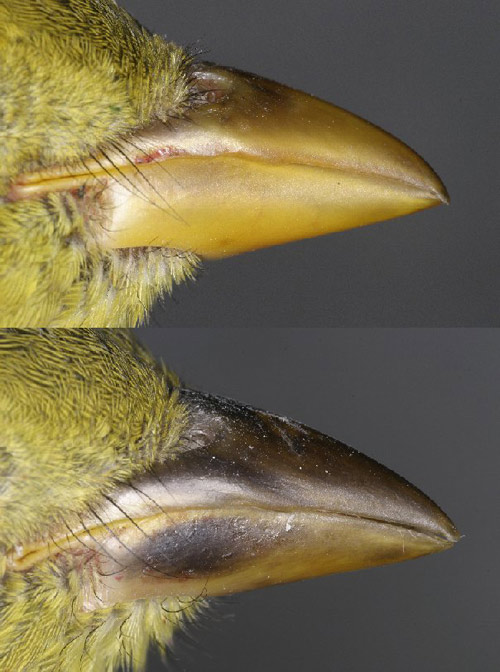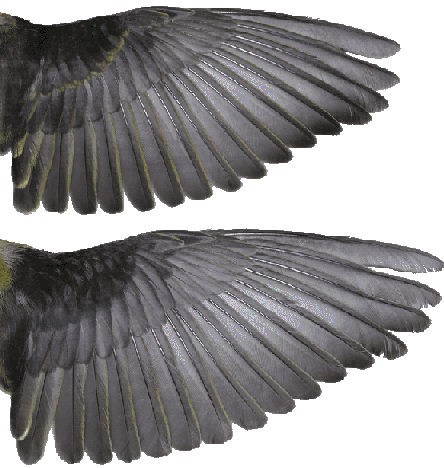
Captured in October 2, 2003
Powdermill Nature Reserve
Variant Scarlet Tanager HY Male, Top
Normal Scarlet Tanager HY Male, Bottom

Variant Scarlet Tanager HY Male, Top
Normal Scarlet Tanager HY Male, Bottom
Wing length of 92.0mm
Tail length 65.0mm
Exposed culmen 13.8mm,
Nares to tip of bill 10.5mm
Bill depth at nares 7.9mm,
Bill width at nares 7.5mm,
Fat score 2 (on a scale of 0-3)
Body mass 34.9 grams.
When we removed it from the net, the top bird's light yellow-orange bill, as well as the odd calls that it gave continually while being extracted (subsequently recorded while the bird was in the banding lab, struck us as odd for a Scarlet Tanager.
In addition, the greenish wingbar on the fresh basic median coverts and the unusually broad greenish edging on the retained juvenal inner secondaries (top wing photo above) were unusual. Scarlet Tanagers, however, are notorious for their wide range of plumage variations. The possibility (O.K., we admit it, it crossed our minds!) that this variant Scarlet Tanager might be a hybrid Scarlet X Western Tanager actually has a precedent--a putative hybrid was collected by Harrison B. Tordoff and colleagues in Minnesota on August 17, 1949 (reported in Wilson Bull. 60: 3-4).
Although we finally concluded that our bird was just another interesting Scarlet Tanager variant (albeit our first ever in-hand vocal variant!), we certainly would be happy to hear comments from other banders or birders concerning the unusual appearance and vocalizations of our bird.
Listen to the calls recorded from this bird after banding.
Shortened clip
Full-length file
Note: The "hu-wee" call near the beginning of the above sound files (given while the bird was sitting in a darkened holding cage) is similar to a Scarlet Tanager's nocturnal call note, sometimes described as "hu-dee" or "pu-wi."
Although we are not familiar with Western Tanager nocturnal flight calls, they are described as being similar to the Scarlet's. This bird's "hu-wee" seemed clearer, shorter, and slightly higher pitched to us than a CD recording of a Scarlet Tanager's "hu-dee" (Evans, W. R., and M. O'Brien. 2002.
Flight Calls of Migratory Birds [CD available through www.oldbird.org]). The bird's repeated "chip" notes from the middle to end of the above clip (given while it was being handled) is unlike any Scarlet Tanager calls we have heard before.
